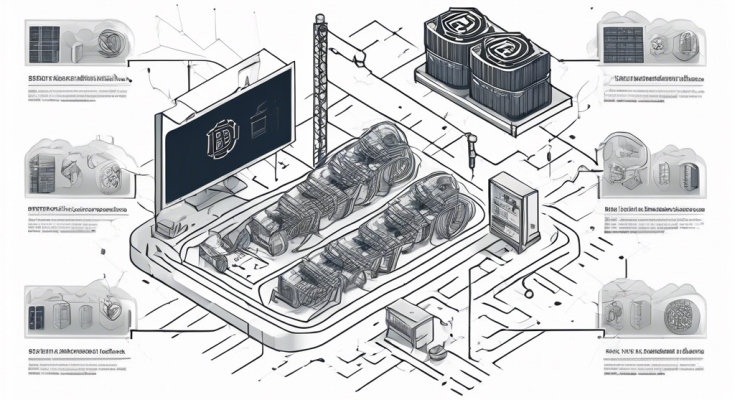Understanding the Basics of Cryptocurrency Mining
What is Cryptocurrency Mining and How Does It Work?
Cryptocurrency mining is the process through which new coins are generated and transactions are verified on a blockchain network. At its core, this activity involves solving complex computational problems that secure the network and ensure the integrity of the blockchain. Cryptocurrency mining plays a crucial role in maintaining and operating decentralized networks, making it an essential aspect of the cryptocurrency ecosystem.
The process of mining can vary depending on the consensus mechanism employed by the cryptocurrency. The two primary mechanisms are Proof of Work (PoW) and Proof of Stake (PoS). Proof of Work involves miners competing to solve cryptographic puzzles, with the first to solve the puzzle earning the right to add a new block to the blockchain and receive a reward. On the other hand, Proof of Stake allocates mining opportunities proportional to the amount of cryptocurrency a miner holds, reducing the need for intense computational power.
The key components involved in cryptocurrency mining include both hardware and software. Specialized hardware such as ASICs (Application-Specific Integrated Circuits) or GPUs (Graphics Processing Units) is used to perform the complex calculations required for mining. Meanwhile, mining software helps miners connect to the blockchain network, manage their mining hardware, and maximize their mining efficiency. Understanding these components and how they work together is essential for anyone looking to delve into the world of cryptocurrency mining.
What is Cryptocurrency Mining and How Does It Work?
Introduction to Cryptocurrency Mining: Definition and Importance
Cryptocurrency mining is a fundamental process in the world of digital currencies. At its core, cryptocurrency mining involves the use of computational power to solve complex mathematical problems that validate transactions on a blockchain network. This process is essential for maintaining the integrity and security of decentralized networks such as Bitcoin, Ethereum, and other cryptocurrencies.
The importance of cryptocurrency mining cannot be overstated. It ensures that transactions are verified and added to the blockchain in a secure and tamper-proof manner. Miners not only confirm transactions but also introduce new coins into circulation through a predefined algorithmic process. This decentralized approach helps maintain trust amongst users and eliminates the need for a central authority to oversee the network.
The Process of Mining: Proof of Work vs. Proof of Stake
Cryptocurrency mining traditionally relies on a consensus mechanism known as Proof of Work (PoW). In a PoW system, miners compete to solve cryptographic puzzles using their computational resources. The first miner to solve the puzzle gets the right to add a new block to the blockchain and is rewarded with cryptocurrency. Bitcoin, the pioneering cryptocurrency, uses this mechanism.
However, PoW is not the only mechanism in place. Proof of Stake (PoS) is an alternative consensus mechanism that is gaining popularity. Instead of miners competing to solve puzzles, validators in a PoS system are chosen based on the number of coins they hold and are willing to stake as collateral. This method is perceived as more energy-efficient compared to PoW, as it does not require intensive computational power. Ethereum 2.0 is a well-known example of a cryptocurrency migrating from PoW to PoS in an effort to improve scalability and reduce energy consumption.
Key Components: Mining Hardware and Software
The effectiveness of cryptocurrency mining largely depends on having the right hardware and software, which form the backbone of the mining process. Mining hardware typically includes high-performance computers equipped with specialized graphic processing units (GPUs) or application-specific integrated circuits (ASICs). These devices are designed to handle the demanding computations required in mining.
GPUs, originally designed for rendering graphics in video games, are widely used in mining due to their high efficiency in performing repetitive calculations. ASICs, on the other hand, are custom-built for specific mining algorithms and offer even higher performance at the cost of reduced flexibility.
In addition to hardware, the software plays a crucial role in managing mining operations. Mining software interfaces with the blockchain network, manages hardware resources, and communicates with mining pools. Popular mining software includes CGMiner, BFGMiner, and EasyMiner, each offering different features and catering to various levels of expertise.
To summarize, cryptocurrency mining is a critical process that underpins the functioning of blockchain networks. Whether through Proof of Work or Proof of Stake, mining ensures the validation and security of transactions. Success in mining requires not only an understanding of these mechanisms but also the right combination of hardware and software.
The Economics Behind Cryptocurrency Mining
Potential Profitability: Rewards and Costs
When diving into the world of cryptocurrency mining, understanding the economics is crucial. The potential profitability of mining is a balancing act between rewards and costs. Miners earn rewards in the form of newly minted coins and transaction fees. For instance, Bitcoin miners receive a certain number of bitcoins (currently 6.25 BTC per block as of 2023) for each block they successfully mine.
However, the rewards must outweigh the associated costs to make mining economically viable. These costs include electricity, hardware, maintenance, and, in many jurisdictions, cooling systems to prevent overheating. If the mining operation’s costs exceed the rewards, the venture becomes unprofitable. Understanding these economic fundamentals allows miners to gauge whether their efforts will yield profits or losses.
Factors Influencing Mining Profitability: Power Consumption, Hash Rate, and Mining Difficulty
Mining profitability hinges on several key factors. Power consumption is perhaps the most significant because mining rigs consume substantial amounts of electricity. Efficient rigs are more cost-effective, making the choice of hardware crucial.
The hash rate is another critical factor. The hash rate refers to the number of computations a mining rig can perform per second. A higher hash rate increases the chances of solving the cryptographic puzzles necessary to add a new block to the blockchain. However, higher hash rates require more powerful (and often more expensive) hardware, further compounding power consumption.
Mining difficulty, which measures how hard it is to mine a new block, also plays a pivotal role. As more miners join the network, the difficulty increases, diminishing the chances of any single miner solving the puzzle and earning rewards. Conversely, if miners leave the network, the difficulty decreases, making it easier and potentially more profitable for the remaining miners. Monitoring mining difficulty and adjusting one’s strategy accordingly ensures more effective and profitable mining operations.
Environmental Impact and Sustainability Considerations
The environmental impact of cryptocurrency mining has become a growing concern. Mining operations, especially those of major cryptocurrencies like Bitcoin and Ethereum, require substantial energy. This energy consumption leads to a significant carbon footprint, raising sustainability concerns.
Some regions have responded by imposing regulations and restrictions on mining activities to curb their environmental impact. For instance, China, a major player in the Bitcoin mining space, has taken steps to limit mining operations due to energy consumption concerns.
To address these issues, the industry is witnessing a shift towards more sustainable mining practices. Renewable energy sources, such as solar, wind, and hydroelectric power, are gaining traction among miners. These alternatives could potentially reduce the environmental footprint while also lowering operational costs in the long run.
Moreover, some cryptocurrencies are exploring more energy-efficient consensus mechanisms like Proof of Stake (PoS) instead of the traditional Proof of Work (PoW). PoS consumes significantly less energy by requiring validators to hold and stake coins rather than solving cryptographic puzzles. Ethereum, for example, has initiated a transition to PoS with its Ethereum 2.0 upgrade, aiming to create a more sustainable and scalable network.
In conclusion, understanding the economics behind cryptocurrency mining involves a balance of profitability, cost management, and sustainability. By carefully considering factors like power consumption, hash rate, mining difficulty, and environmental impact, miners can optimize their operations for better financial returns and contribute to a more sustainable mining ecosystem.
Getting Started with Cryptocurrency Mining
Choosing the Right Cryptocurrency to Mine
As you begin your journey into cryptocurrency mining, the first crucial step is deciding which cryptocurrency to mine. While Bitcoin often comes to mind, there are numerous other cryptocurrencies worth considering, including Ethereum, Litecoin, and Monero. Each cryptocurrency has its own unique algorithm, mining difficulty, and potential profitability.
Bitcoin uses the SHA-256 algorithm, which requires substantial computing power to solve complex mathematical problems. Ethereum, on the other hand, uses the Ethash algorithm, which is designed to be resistant to ASIC hardware and is more suitable for GPU mining. Factors such as market demand, mining difficulty, and the potential return on investment should govern your choice. Research each cryptocurrency’s specific requirements and profitability metrics to make an informed decision.
Setting Up Your Mining Rig: Hardware, Software, and Configuration
Once you’ve chosen a cryptocurrency, the next step is setting up your mining rig. The hardware required varies based on the cryptocurrency you’ve selected. For Bitcoin mining, high-efficiency ASIC (Application-Specific Integrated Circuit) miners are necessary. In contrast, for Ethereum mining, a rig equipped with multiple high-performance GPUs (Graphics Processing Units) is more favorable.
Building a mining rig involves several components:
- Motherboard: A motherboard that supports multiple GPUs is essential for optimal mining performance.
- GPU: When mining GPUs, more powerful GPUs mean faster hash rates, which equals higher profits.
- Power Supply Unit (PSU): A robust and reliable PSU that can handle the power requirements of all your components.
- Cooling System: Effective cooling solutions, such as fans and heatsinks, to maintain optimal temperatures and prevent overheating.
- Software: Installing mining software appropriate for the cryptocurrency you’re mining. Popular options include CGMiner, BFGMiner, and EasyMiner.
The mining software connects to the blockchain network to solve calculations required for transaction validation and block creation. Configuration settings in the software, such as pool management, user settings, and wallet address input, need to be adjusted to maximize efficiency.
Tips for Optimizing Mining Efficiency and Staying Updated with Trends and Best Practices
Efficiency is key in cryptocurrency mining, given the high operational costs, including electricity and hardware maintenance. Here are some tips to optimize your mining operations:
- Maximize Hash Rate: Overclock your GPU or ASIC without compromising the stability to achieve a higher hash rate. Many miners use specialized BIOS settings and software to tweak performance.
- Minimize Power Consumption: Use energy-efficient hardware or mine during off-peak hours to cut down electricity costs. In some regions, renewable energy solutions can also provide more sustainable options.
- Temperature Control: Keeping your rig cool is vital. Use high-quality thermal paste, ensure proper ventilation, and invest in additional cooling solutions to maintain hardware performance.
- Regular Maintenance: Periodic cleanings can prevent dust accumulation, which can dampen cooling efficiency and lead to overheating or hardware failure.
Staying updated with the latest trends and best practices in cryptocurrency mining is also crucial for sustained profitability. Online forums, specialized mining communities, and cryptocurrency news outlets are excellent resources for staying informed. Engage in active mining forums like Reddit’s r/EtherMining or participate in discussions on platforms like Bitcointalk to gather insights and share experiences with fellow miners.
Additionally, as blockchain technology evolves, new cryptocurrencies and mining algorithms emerge. By keeping tabs on industry developments, you can adapt your strategies, invest in emerging opportunities, and leverage advancements to enhance efficiency and profitability.
Getting started with cryptocurrency mining entails a strategic selection of cryptocurrencies, setting up a specialized rig, and adopting practices to optimize operational efficiency. Staying updated with trends and community insights will help navigate the evolving landscape of cryptocurrency mining, ensuring a rewarding and profitable venture.
Conclusion
Cryptocurrency mining is a fascinating and multifaceted endeavor that combines cutting-edge technology with economic opportunity. By understanding the basic principles of what cryptocurrency mining entails, how it operates, and the economic implications, prospective miners can make informed decisions about entering this dynamic field.
Evaluating the Landscape
While the potential for profitability in cryptocurrency mining exists, it is crucial to consider both the monetary costs and the environmental impacts. The balance between energy consumption, hardware efficiency, and mining difficulty plays a significant role in determining the feasibility of a mining operation. As technology evolves and the cryptocurrency market fluctuates, staying informed about the latest advancements and trends is paramount.
Starting Your Mining Journey
For those ready to dive into cryptocurrency mining, choosing the right cryptocurrency, setting up a competent mining rig, and optimizing operational efficiency are critical steps. With diligent planning, continuous learning, and strategic adjustments, individuals can carve out a successful niche in the competitive world of mining.
Looking Forward
As the cryptocurrency landscape continues to evolve, so too will the strategies and technologies associated with mining. By leveraging current best practices and staying adaptable to new developments, miners can not only participate in this innovative field but also contribute to its growth and sustainability. Whether you are mining as a hobby or pursuing it as a business venture, understanding the basics of cryptocurrency mining sets the stage for future success.





